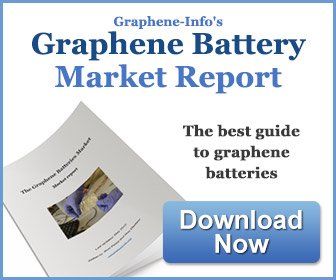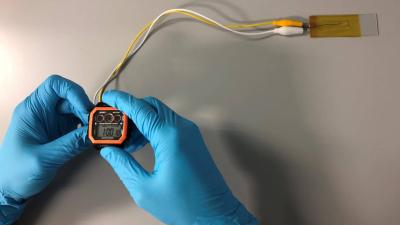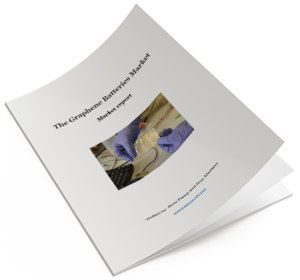Graphene and batteries
Graphene, a sheet of carbon atoms bound together in a honeycomb lattice pattern, is hugely recognized as a “wonder material†due to the myriad of astonishing attributes it holds. It is a potent conductor of electrical and thermal energy, extremely lightweight chemically inert, and flexible with a large surface area. It is also considered eco-friendly and sustainable, with unlimited possibilities for numerous applications.
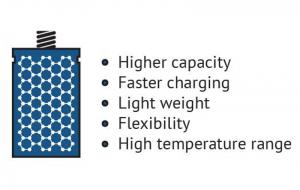 The advantages of graphene batteries
The advantages of graphene batteries
In the field of batteries, conventional battery electrode materials (and prospective ones) are significantly improved when enhanced with graphene. A graphene battery can be light, durable and suitable for high capacity energy storage, as well as shorten charging times. It will extend the battery’s life, which is negatively linked to the amount of carbon that is coated on the material or added to electrodes to achieve conductivity, and graphene adds conductivity without requiring the amounts of carbon that are used in conventional batteries.
Graphene can improve such battery attributes as energy density and form in various ways. Li-ion batteries (and other types of rechargeable batteries) can be enhanced by introducing graphene to the battery’s anode and capitalizing on the material’s conductivity and large surface area traits to achieve morphological optimization and performance.
It has also been discovered that creating hybrid materials can also be useful for achieving battery enhancement. A hybrid of Vanadium Oxide (VO2) and graphene, for example, can be used on Li-ion cathodes and grant quick charge and discharge as well as large charge cycle durability. In this case, VO2 offers high energy capacity but poor electrical conductivity, which can be solved by using graphene as a sort of a structural “backbone†on which to attach VO2 - creating a hybrid material that has both heightened capacity and excellent conductivity.
Another example is LFP (Lithium Iron Phosphate) batteries, that is a kind of rechargeable Li-ion battery. It has a lower energy density than other Li-ion batteries but a higher power density (an indicator of of the rate at which energy can be supplied by the battery). Enhancing LFP cathodes with graphene allowed the batteries to be lightweight, charge much faster than Li-ion batteries and have a greater capacity than conventional LFP batteries.
In addition to revolutionizing the battery market, combined use of graphene batteries and graphene supercapacitors could yield amazing results, like the noted concept of improving the electric car’s driving range and efficiency. While graphene batteries have not yet reached widespread commercialization, battery breakthroughs are being reported around the world.
Battery basics
Batteries serve as a mobile source of power, allowing electricity-operated devices to work without being directly plugged into an outlet. While many types of batteries exist, the basic concept by which they function remains similar: one or more electrochemical cells convert stored chemical energy into electrical energy. A battery is usually made of a metal or plastic casing, containing a positive terminal (an anode), a negative terminal (a cathode) and electrolytes that allow ions to move between them. A separator (a permeable polymeric membrane) creates a barrier between the anode and cathode to prevent electrical short circuits while also allowing the transport of ionic charge carriers that are needed to close the circuit during the passage of current. Finally, a collector is used to conduct the charge outside the battery, through the connected device.
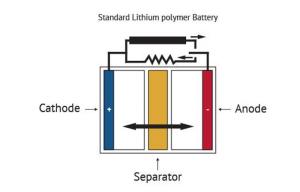
When the circuit between the two terminals is completed, the battery produces electricity through a series of reactions. The anode experiences an oxidation reaction in which two or more ions from the electrolyte combine with the anode to produce a compound, releasing electrons. At the same time, the cathode goes through a reduction reaction in which the cathode substance, ions and free electrons combine into compounds. Simply put, the anode reaction produces electrons while the reaction in the cathode absorbs them and from that process electricity is produced. The battery will continue to produce electricity until electrodes run out of necessary substance for creation of reactions.
Battery types and characteristics
Batteries are divided into two main types: primary and secondary. Primary batteries (disposable), are used once and rendered useless as the electrode materials in them irreversibly change during charging. Common examples are the zinc-carbon battery as well as the alkaline battery used in toys, flashlights and a multitude of portable devices. Secondary batteries (rechargeable), can be discharged and recharged multiple times as the original composition of the electrodes is able to regain functionality. Examples include lead-acid batteries used in vehicles and lithium-ion batteries used for portable electronics.
Batteries come in various shapes and sizes for countless different purposes. Different kinds of batteries display varied advantages and disadvantages. Nickel-Cadmium (NiCd) batteries are relatively low in energy density and are used where long life, high discharge rate and economical price are key. They can be found in video cameras and power tools, among other uses. NiCd batteries contain toxic metals and are environmentally unfriendly. Nickel-Metal hydride batteries have a higher energy density than NiCd ones, but also a shorter cycle-life. Applications include mobile phones and laptops. Lead-Acid batteries are heavy and play an important role in large power applications, where weight is not of the essence but economic price is. They are prevalent in uses like hospital equipment and emergency lighting.
Lithium-Ion (Li-ion) batteries are used where high-energy and minimal weight are important, but the technology is fragile and a protection circuit is required to assure safety. Applications include cell phones and various kinds of computers. Lithium Ion Polymer (Li-ion polymer) batteries are mostly found in mobile phones. They are lightweight and enjoy a slimmer form than that of Li-ion batteries. They are also usually safer and have longer lives. However, they seem to be less prevalent since Li-ion batteries are cheaper to manufacture and have higher energy density.
Batteries and supercapacitors
While there are certain types of batteries that are able to store a large amount of energy, they are very large, heavy and release energy slowly. Capacitors, on the other hand, are able to charge and discharge quickly but hold much less energy than a battery. The use of graphene in this area, though, presents exciting new possibilities for energy storage, with high charge and discharge rates and even economical affordability. Graphene-improved performance thereby blurs the conventional line of distinction between supercapacitors and batteries.
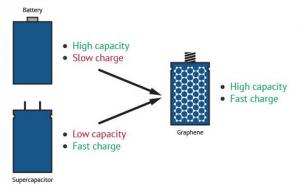 Graphene batteries combine the advantages of both batteries and supercapacitors
Graphene batteries combine the advantages of both batteries and supercapacitors
Graphene-enhanced batteries are almost here
Graphene-based batteries have exciting potential and while they are not yet fully commercially available yet, R&D is intensive and will hopefully yield results in the future. Companies all over the world (including Samsung, Huawei, and others) are developing different types of graphene-enhanced batteries, some of which are now entering the market. The main applications are in electric vehicles and mobile devices.
Some batteries use graphene in peripheral ways - not in the battery chemistry. For example in 2016, Huawei unveiled a new graphene-enhanced Li-Ion battery that uses graphene to remain functional at higher temperature (60° degrees as opposed to the existing 50° limit) and offer a double the operation time. Graphene is used in this battery for better heat dissipation - it reduces battery's operating temperature by 5 degrees.
Further reading
- Introduction to graphene
- Graphene Supercapacitors
- How to invest in the graphene revolution
- The Graphene Handbook, our very own guide to the graphene market
- Graphene-Info's graphene batteries market report
- Graphene supercapacitors market report
The latest graphene batteries news:
CA2DM@NUS and CBMM develop advanced niobium-graphene batteries with 30-year lifecycles
The Centre for Advanced 2D Materials (CA2DM) at the National University of Singapore (NUS), focused on the research of graphene and other 2-dimensional (2D) materials, and CBMM, a leader in niobium products and technology, have developed new niobium-graphene batteries.
The batteries are currently being tested at the new CBMM-CA2DM Advanced Battery Laboratory which was recently launched by NUS and CBMM (established with a joint investment of USD$3.8 million) over three years, supported by the National Research Foundation, Singapore.
GMG announces graphene aluminium-ion battery Joint Development Agreement with Rio Tinto
Graphene Manufacturing Group (GMG) has announced the signing of a binding Joint Development Agreement ("JDA") with Rio Tinto, with the goal of accelerating the development and application of GMG's Graphene Aluminium-Ion batteries in the mining and minerals industry. Rio Tinto will contribute technical and operational performance criteria and A$6 million (over USD$3,900,000), in exchange for preferential access rights.
The JDA seeks to support the accelerated development of GMG's Graphene Aluminium-Ion Batteries for use in heavy mobile equipment and grid energy storage applications in the mining and mineral industry. The JDA builds on the existing collaboration for Rio Tinto to explore the use of GMG's Energy Saving and Energy Storage solutions (announced May 2022). This JDA is effective immediately and is expected to last 2 years with payments spread over the term of the agreement. The JDA aims to co-develop GMG's Graphene Aluminium-Ion battery pouch cell into an initial battery pack/module proof of concept.
Researchers develop graphene-based cathode in the shape of a thread-like fiber
Researchers at North Carolina State University (NC State), National Science and Technology Development Agency and NSTDA Characterization and Testing Service Center in Thailand have created a graphene-based cathode in the shape of a thread-like fiber. The researchers were then able to use the fiber to create a zinc-ion battery prototype that could power a wrist watch.
Battery prototype with thread-like cathode. Image from NCSU website
The proof-of-concept study is a step forward in the development of a fiber-shaped battery that could ultimately be integrated into garments.
Skeleton & Martinrea to collaborate on batteries for refuse trucks
It was recently reported that Skeleton Technologies and the Canadian automotive supplier Martinrea International are cooperating to equip refuse collection vehicles for use in Paris and New York with Skeleton’s ‘SuperBattery’ technology.
Martinrea International develops and produces electric vehicle technologies for heavy-duty commercial vehicles through its subsidiary Effenco. The aim of the agreement with the Estonia-based Skeleton is to electrify fleets of refuse collection vehicles in Europe and North America, starting in New York City and Paris, and later to make the solution developed by both companies available worldwide. In autumn 2022, Shell had already become known as the first major customer for the graphene battery solution. Shell wants to use it to create electrification solutions for mining sites.
The Graphene Batteries Market Report - a new edition (2023-04)
Today we published a new edition of our Graphene Batteries Market Report, with all the latest information. The batteries market is extremely active, as demand from EVs and mobile applications increases research and development efforts, and graphene is seen as a potential material to increase capacity, decrease charging times and improve other performance metrics. Indeed the new edition contains over 10 new updates, with recent achievements and projects.
Reading this report, you'll learn all about:
- The advantages of using graphene in batteries
- The different ways graphene can be used in batteries
- Various types of graphene materials
- What's on the market today
The report package also provides:
- A list of all graphene companies involved with batteries
- Detailed specifications of graphene-enhanced anode materials
- Personal contact details into most graphene developers
- Free updates for a year
This Graphene Batteries market report provides a great introduction to graphene materials used in the batteries market, and covers everything you need to know about graphene in this niche. This is a great guide for anyone involved with the battery market, nanomaterials, electric vehicles and mobile devices.
Evonik invests in Chinese graphene batteries company SuperC
German specialty chemicals company, Evonik, has invested (through its venture capital unit, Evonik Venture Capital (EVC)) in Chinese battery specialist SuperC. The Chinese company develops and produces graphene materials that improve the range, robustness, charging speed, and service life of lithium-ion batteries, aiming to solve key limitations of electric vehicles and accelerate the shift to climate-friendly mobility.
"By investing in SuperC, we are supporting a cutting-edge technology with a promising future. High-performance batteries are a crucial factor in accelerating the electrification of road transport and permanently reducing CO2 emissions," says Bernhard Mohr, head of Evonik's venture capital unit. The investment was made by the Sustainability Tech Fund launched in 2022, which has a total investment volume of €150 million. The Group is thus also strengthening its sustainability goals by investing in an innovative technology and business model. The focus of the fund is on new technologies to reduce emissions as well as innovations that complement Evonik's Next Generation Solutions.
Nanoxplore announces purchase of Martinrea International's stake in Voltaxplore
NanoXplore and Martinrea International, a global automotive supplier engaged in the design, development and manufacturing of highly engineered, value-added Lightweight Structures and Propulsion Systems, through its subsidiary, Martinrea Innovation Developments, have announced NanoXplore's purchase of Martinrea Innovation's 50% equity stake in VoltaXplore.
NanoXplore now owns 100% of the equity and intellectual property in VoltaXplore and Martinrea has increased its existing equity position in NanoXplore from 21.1% to 22.7%. VoltaXplore was formed as a joint venture between NanoXplore and Martinrea in 2021 to collaborate on developing graphene-enhanced Li-ion battery cells for electric vehicles and grid storage and to explore the potential to build a battery gigafactory. NanoXplore will seek to finance the battery gigafactory within VoltaXplore.
HydroGraph signs LOI for a graphene-batteries project with CGT and LOLC
HydroGraph Clean Power, manufacturer of graphene and other nanomaterials, has announced a letter of intent (LOI) to form a partnership with Ceylon Graphene Technologies (CGT) via LOLC Advanced Technologies (LOLC AT), which owns a majority share of CGT through a joint venture with Sri Lanka Institute of Nanotechnology (SLINTEC).
The partnership will center around a novel composite graphene blend that is said to improve the charge acceptance of lead acid batteries by 47%. HydroGraph and LOLC AT agreed to commercialize this product and pursue the lead acid battery market, projected to be worth more than $47 billion by 2030, driven in part by electric vehicle dependency on the product.
Lyten Selected for the Amazon Web Services Clean Energy Accelerator 3.0
Lyten has announced its selection for the Amazon Web Services (AWS) clean energy accelerator 3.0, as one of the 15 startups that will participate in the non-equity dilutive accelerator designed to facilitate collaborations with mature startups developing breakthrough clean energy technologies.
The program is focused on fostering innovation and rapid growth of clean energy technology, which is needed to address the global climate crisis.
GMG receives regulatory development approval for battery plant
Graphene Manufacturing Group (GMG) has announced the receipt of regulatory and local council approvals for the commercial scale manufacturing of batteries at its existing Richlands site in Brisbane, Australia. To date GMG has been adhering to a research and development regulatory approval to make battery cell prototypes. In addition, this site already has council approvals that allow GMG to manufacture its graphene.
These regulatory approvals are seen an important step in GMG’s consideration at an appropriate future time to build and operate a battery manufacturing plant at the GMG Headquarters at Richlands.
Pagination
- Previous page
- Page 5
- Next page
